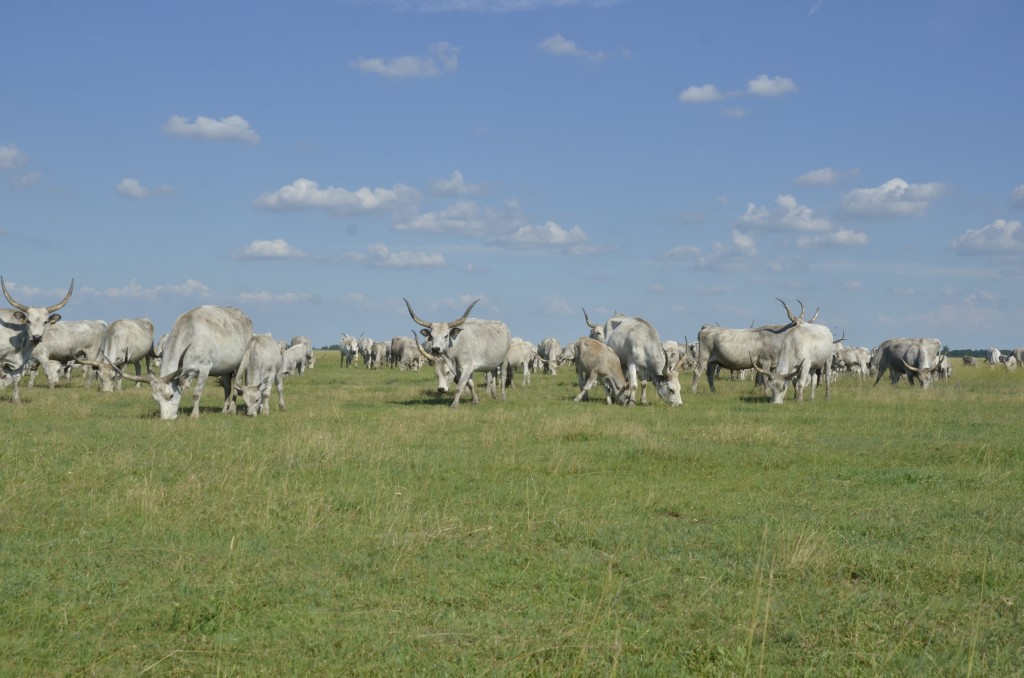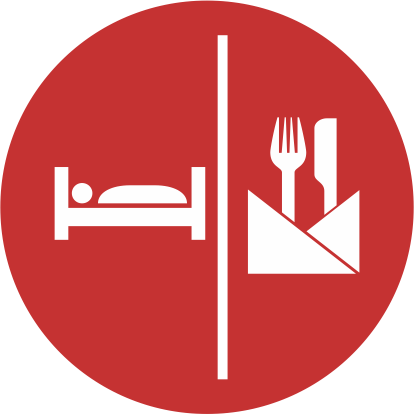Grazing animal husbandry on the puszta I.
Breeds and herd-organizations
Cattle herding on the Hortobágy was practised in the traditional way, even at the beginning of the 20th century. As it is recorded by István Ecsedi in an almost dramatic manner: the cattle usually kept poorly in the winter lives under the open sky of the Lord from springtime until the autumn; it does not have sufficient forage and water to drink during the often dry period; the primitive resting-places do not provide real protection, it has to lie on the muddy, cold ground; and the hot sun also tells upon men and cattle as well. So such a breed should be kept that is able to bear all kinds of difficulties. Only the Hungarian Grey Cattle was adapted for being raised on the Hortobágy puszta.
It was a long-lasting belief that the Magyars of the Conquest brought this breed with themselves, and later the Cumanians were believed to be the ones who naturalized it. However, it seems more probable that this race was bred here, in the Carpathian Basin. The smaller cattle brought by the Hungarians was cross-bred with the large, ancient steer found here. From this aspect, the term "Hungarian Grey Cattle" is justified. A Transylvanian variant of the same cattle was known and, at the turn of the century, a bluish-grey, so-called kun (Cumanian) breed in the Kunság was also recorded.
The situation of horse-breeding was different though. The community of Debrecen kept horses for a long time past. The first traces go back as far as the end of the 17th century. That was the first base-stud of the town and was kept to provide the town with work-horses. It was a rather mixed stud, mostly of small, but hardy horses. In the stud renewed in 1773 noble breeds were also tried out, but without much success. Later, in 1828, when the next stud was established, horses, mostly Spanish breeds, were bought from well-known studs. The real breed-shifting has not come about until 1885, when the town's stud was out-bred by the Nóniusz horse. This breed became world-famous at the beginning of the 20th century.
The most ancient breed of sheep of the Hungarians is the curly, long furred Racka. On the Hortobágy it was called "riskás". The extremely hardy Racka sheep disinclined to disease endured the hardships of being kept on the Hortobágy; sometimes the flock was out on the puszta during the whole winter. Several varieties of the Racka were known, for example the Racka of Hortobágy (Ovis strepsiceros Hortobagyensis) that was kept all over the Alföld (the Great Plain) and in the Bakony, too. The buck and the female sheep both have upright, tip-tilted, twirled horns and this kind is called "Hungarian sheep" by the Gorals of the Tátra-region. The other isthe Transylvanian Racka that has slightly twirling, horizontal horns, though the female sheep usually does not have horns. "Purzsa" or "purzsás" sheep were also recorded on the Hortobágy, which came with the shepherds leasing the pasture.
The great change in sheep-breeding came with the appearance of the Merino sheep of Spanish origin which has flossy wool. From the end of the 18th century its spread was helped by the wool business, because the coarse wool of the Racka did no longer meet the requirements of the merchantry. In the beginning the farmers loathed it because a formerly unknown disease accompanied it, the follicular mange. The first flock of Merino sheep on the Hortobágy was kept in the very corner of the pasture, by the bounds of Angyalháza, on the Téglahát, almost in quarantine. It was not even called juh (sheep), only birka. Because of its fastidious nature, the Merino required thorough attention. It was cotted and kept on fodder during the winter. One had to be careful during the Merinos' fall as well. By the end of the 19th century the kétnyiratú (double chip) Merino thoroughly outplaced the native Racka breeds because of its precious wool and its being a heavy milker. The keeping of Merino sheep prevailed all over the Hortobágy.
In this land the szalontai or réti (meadow-) swine are considered ancient breeds. But the Mangalica that is more inclined to corpulence and gives tenderer meat outplaced this breed by the middle of the 19th century. However, the Mangalica is a fancy breed, a cross-bred of the Serbian sumádia and the Hungarian Bakony swine.
The livestock all over the Hortobágy is numerous in every period, although it never bore proportion to the vast area of pastures. Exact data concerning the number of the grazed animals are available from the 1860s. The highest number of animals was recorded in 1880, when 17,811 cattle and horses, 27,971 sheep and 9,610 swine, in total 55,492 animals were counted. This number concerned the livestock of Debrecen and its owner-society though. The livestock of the neighbouring settlements grazing on the areas of the Hortobágy should also be added, because these pastures belong to the puszta as well. So the number can be as high as 200,000.
The grazing animals appear in certain units in extensive breeding. These units are called nyáj (herd or flock) in short, which is a word of Turkish origin and identical with the term "to graze". In the old Hungarian vernacular, in the Hortobágy as well, the terms lónyáj, nyájasló (flock of horses) were in use, but later this term was confined to refer to sheep only. The falka, darab, tőke represented smaller units inside the flock, meaning livestock-units belonging to certain owners. The concept ünöm has become extinct in our language, yet it should be mentioned because ethnographers discovered it on the Hortobágy in the 1930s. It refers to a bunch of animals of different ages, but from the same parentage.
The number of animals in a flock is varied, it depends on their species, the size and quality of the pasture and the water supply conditions? The stud, the herd comprises an average of 500 animals, but can be three times as much, too. The number of the swine and the infecund sheep can be similar, but the flock of milch-ewe is usually much smaller since the shepherd has a lot of work with milking. The number of the hired shepherds depend on the size of the flock. In case of horses or cattle, every 100 animals take one herdsman. The swine and the sheep can be managed with fewer shepherds.
The shepherds of the Hortobágy
The shepherds of the Hortobágy form a determining part of the traditionalist community that the ethnographic literature calls "the shepherds' order". In case of the Hortobágy the shepherds were carriers and vivifiers of a particular culture more archaic than that of the peasants until the middle of the 20th century.
The order of pasturing on the Hortobágy puszta and the specific shepherds' society had been developed by the 18th century. After that, the municipal council and the community of owners hired the shepherds.
In the beginning most of the shepherds were from Debrecen, e.g. from the 83 shepherds listed in 1783 49 professed themselves inhabitants of Debrecen, 22 coming from the neighbouring villages and only 12 came from more distant regions. However, in 1914 Ecsedi wrote that the shepherds of the Hortobágy were not natives of Debrecen, but most of them were from Polgár, Tiszacsege, Egyek, Nagyiván, Tiszaigar and from Nádudvar.
According to the inexpert public opinion, all of the shepherds are situated on the very bottom of the hierarchy of the village society, right next to the servantry. This opinion is only true if the village herder and swine-herd are considered. On the other hand, if we examine the shepherds' society more thoroughly, it turns out that during feudalism not only cotters, but also sons of landowners and armalis nobles could also become shepherds. Because the manors, and especially the town of Debrecen and its owner-community, would not have committed the valuable livestock to the care of penniless, wanting people, it trusted people who had some wealth and some livestock of their own. Naturally, such requirements concerned only the számadó (the leader of the herdsmen) responsible for the animals. The bojtárs (herdboys), on the other hand, were hired by the számadó and he answered for them. "While the herdboys are often really wanting people, the számadó always comes from a respectful family, the crested shepherds are coming from dynasties."
Choosing the számadó required real circumspection. His hiring was almost solemnized by the owners. Sándor Vigh, a leader of herdsman, told the story of his hiring in 1941 as it follows: "I visited the first owner, the squire István Némethy, before Christmas. I told him what my errand was: "I would like to take a flock of animals." He asked me how I am off for money. When I told him, he answered: "Hey, I'm gonna bear you in mind." I also visited another owner, Ferenc Nyilasi, but he wasn't half as kind, 'cause he snapped at me: "Well buddy, what do you want?" So I realized that he had already picked his man. The számadó selection was held on the second day of Christmas. We gathered in the owners' reading circle. There the court-crier cried out the names. My name was cried as well. I went in and stopped before the long table where the owners were sitting and they eyed me up and down. First, they interrogated me and I could leave. Then those up to the mark were called again. They informed us which cattle or stud we were going to be számadós of. The wage was also told. We could not argue over it, because many people competed for one place. In 1941, my wages were 2,000 pengős, 10 kilograms wheat and 5 decagrams lard per animal. Afterwards I decently bowed and they said: "Good luck, be a real man and hire good herdboys!" Outside, the companions waiting there immediately asked: "Well, is your bag heavier now?"
The hired leaders gathered at the pub named "Háromzsidólány" ("Three-Jewish-Girl"), by the Kisállomás (Small-station). Here they met those companions whose bag did not become heavier. Usually, the herdboys were selected from them. The time of their actual hiring was the fair on the 20th of January. The little-herdboy was selected from the children of the relatives at home.
The shepherds' society had a hierarchic structure. The most respectable is the számadó, the leader (called bacsu in case of sheep) who answers for the livestock he is trusted with. He commands the herdboys, his word decides. The next is the számadó- or old-herdboy. Similarly to the leader, he is also a married man, with a little property. The herdboys are young, unmarried men, before the military service. The little-herdboy and the tanyás (~ stead-keeper, carter) are children. This hierarchy is also represented in the wages. The daily grazing and watering is done as the számadó assigns it. Only the tanyás's task is different. He is the one who cooks and takes the dinner out to the cattle-camp, he guards the fire in the vasaló (herdsman's hut), and tends the "shepherds' fire" during the late autumn grazing to guide his companions in the darkness.
The rank of the shepherd also depended on where he served. The shepherds of the Hortobágy ranked the highest, because "the real shepherd served the town of Debrecen". The others follow him, the village herder and the swine-herd are at the bottom of the ranking.
In this society the kind of livestock one was herding also influenced the shepherd's ranking and prestige. Keepers of valuable large-animals (horses, cattle) were held in the highest esteem. There is hardly any difference between the csikós (rangeman) and the cow-herder. The rangeman outstands because of his stiff-neck and pride and the fact that the horse is a valuable animal, sprightly but can be easily injured and its driving wants an experienced, skilful man. In possession of such talents, it is no wonder the rangeman was esteemed high. In the 1930s, "Count" János Czinege of Nagyivány and János Kardos from Böszörmény, who wrote a book about his memories of being a shepherd stood pre-eminent among them. But the cowherd was by no means inferior, because he also rode a horse and the cattle was also valuable. In the Hortobágy region the cowherd has the longest history among the herdsmen keeping large-animals. Occasionally, he herded horses together with the cattle. In the novel "Yellow Rose" by Mór Jókai, the cowherd is presented as a man of energy who is determined, but also calm. The shepherd (sheep-herder) is the "Háry János" (~taradiddler) of the herdsmen. He is a great storyteller. He has time to dabble in art by the flock of sheep (not in case of milch-sheep) and they really excel in shepherds' art. Many of them could gather a little wealth by herding. During the 19th century, the magatarti (those who had their own stock as well) shepherds were deriving from among them. Keeping the swine out on the pasture during summer and winter tried the swine-herd real hard. He was condemned to loneliness without any chance to converse or to bedizement.
Keeping a tally of the stock
"In the springtime, at the driving,
Any squint-eyed can be a herdsman.
But in the autumn, at the tightening
Those who count are the herdsmen!"
The herdsman's work started with counting the animals before driving them out to the pasture. The illiterate, innumerate shepherd had to be familiar with "tallying". The tally-stick (- a wooden stick to be carved on) was used for this. Tallying was kept on tetra-, hexa- or oxagonal tally-sticks according to owners, where the numbers, which resembled to Roman numerals, were carved from right to left by a jack-knife. One end of the tally-stick was the head where the owner's sign was carved. Increase was carved onto the tőkerovás (~stock-tally) divided by a line from the other numbers, while the number of perished animals was carved onto the dögrovás (~carcase-tally). In order to prevent the forging of the tally-signs, they invented the párosrovás (double-tally) that meant the splitting of the tally-stick to halves. One half was given to the owner and the original score could be checked at the autumn driving-in by joining the two halves. The old shepherds knew the practice of tallying even at the beginning of the 20th century, but then it was replaced by the flock-books (irkas).
The identification of the stock by its owner was helped by means of earmarks and branded property marks (bilyog). However, a worth-while shepherd could tell it by the animals' natural marks and characteristics "because, as two identical men do not exist, the animals are also differing from each other". The colour, the shades of colour, its poise, its age, the shape of the horn, etc. are often more telling signs than the otherwise forgeable, "blemishable" marks. The earmarks were mostly used for sheep. The different marks on each ear provided great variability. Each had different names (rózsás, ájos, etc.). Earmarks were used all over Europe. Nevertheless, the owner recognized his own cattle, which had grown since the springtime driving-out, more easily by the branded property mark. If the animal had perished, the shepherd could more easily account for it with the branded furs. The bilyogzó (the marker) was made of iron and by heating it the shepherd pressed it onto the bottom, or sometimes the neck, of the animal (usually cows, occasionally horses). The word bilyog of Turkish origin let us assume that the Magyars of the Conquest had been familiar with it. Because of the spreading cattle-lifting, its usage was regulated by enactment from the 18th century onwards. The branded property mark usually represented the initial letters of the owner's name. The letters "DV" were applied on the stock of the town of Debrecen. The shepherds also used the so-called "szoktatójel" (habituation sign) that represented horse-shoe, sickle, hammer, etc. and were made of wood. These were twin signs, one of them was hanging on the suckler, the other on the lambkin and it informed the shepherd which one was the mother of the little lamb. This practice of marking was brought to Hungary and to the Hortobágy together with the Merino sheep.
Shepherding the flock
It was the shepherd's natural obligation to save the stock, even if it costed his own life. In the 18th century shepherds were already provided with arms against the wild beasts, but they could also use it against the cattle-lifters and marauders. The point was not to let the stock driven away. It was easier to defend the flock against the wolves. One had to know well the practices of evil-doers: how to force the stud, the herd to run away by smoking cow-nail, hair or foot-rag in the pipe. That was the easiest way to "purloin" the stock.
The larger is the stock and the smaller is the pasture, the more difficult is to shepherd it. When there is heat, the flock gets full of "bugs" because of the parasites. When there is thunder and lightning, the flock comes asunder. The stock had to be guarded against the mosquitoes by smoking.
The bell and the cow-bell (csengő and kolomp) were to keep the flock together. All the animals follow the one with the bell in the neck. The shepherd hanged a high- and sharp-sounding bell onto the stirring animal inclined to wandering. The cow-bell (kolomp or "harang") suits the cattle, the bell (csengő) suits the horses. The ram gets a kolomp in the flock of sheep, while the dog receives a pergő (a smaller, sharper-sounding bell).
The most important tool of shepherding is the stick. The rangeman does not use it. The shepherd makes himself it from the offshoot of a chosen oak, dogwood, plum- or pear-tree. In order to produce a nice, rugged stick, the shepherd hacks it with his knife one year before cutting. After cutting he ripens it in dung, he "reddens" it. He also besmears it with white lime and lard to make it shiny. It is not only a tool of shepherding, but a throwing-weapon, a seat when held between the legs, and it gives a shadow from the sun when stuck into the ground and covered with the felt-cloak. It has two types: the formerly described one is the bunkósbot (bludgeon) and the other is the kampósbot (hooked stick) used by the shepherds. The hooked stick is used to fish out a sheep from the flock. The other important tool of shepherding is the whip. That has two types as well: the long-shafted one used by the wagoners and the short-shafted karikás ("ringed-whip") of the shepherds.
The pányváskötél (noose) is used to fish out the unruly animal not accustomed to man. In the neighbouring Kiskunság (Little-Cumania) it is called árkány. The 8 or even 14 metres long noose was formerly made of horse-hair but later it was made of hemp by the cord-maker. On one end there was a ring, and the loop was made roven through that. The chosen animal was driven against the well at the time of watering and the noose was thrown onto its neck. Because of the horns, rudaspányva (pole-noose) was applied to cows.
The well-trained saddle horse was a real companion of the rangemen and the herdsmen in driving and shepherding the flock. The counties prohibited the shepherds' use of saddles until the middle of the 19th century. That is why the so-called "rangeman's saddle" was invented: a rug (patrac, priccs) over the horse's back with the stirrups hanging on a single strap. The shepherd's companion is the donkey that was used rather as a pack animal and not as a shepherding one. The shepherd without an accommodation made a kind of wooden saddle similar to the sawyer's trestle that was called tergenye. He put his clothes and his most important tools onto it. That is why this animal was called "clothes"- or tergenyés donkey on the Hortobágy.
The clever shepherd dogs also played an important role in guarding the stock. Two kinds can be distinguished: the larger-bodied guarding-protecting komondor and kuvasz and the smaller-bodied driving dogs, the puli, the pumi and the mudi. Documents from the 16th-17th century referred to the komondor as the Cumanians' dog, and to the kuvasz as the peasants' dog. Both of them were kept against wolves and later they were used as the guard-dogs of farmsteads. The clever puli, that has excellent talent to drive the flock, was primarily kept by shepherds but the herdsmen also used it. The kuvasz and the komondor are autochtonous, while the puli did not appear until the 18th century and its appearance can be connected with the naturalization of the Merino.
Watering and salting
The grazing animals had to be watered. The horse is the most sensitive to water, so it had to be watered from the well, or formerly from streams or rivers, like the Hortobágy, the Árkus or even the Tisza. The other animals could be kept on still water. Before the regulation, in times of dry weathers the shepherds dug "mud-wells" into the beds of extinct ponds. This kind of well was rectangular and its opposing sides were sloping to help the animals reach the water. While the ground-water was high, the shepherd dug a 0.5-1 meter deep "kopolya" (a kind of small well) for his own use and sipped the defecated water through a reed-sipper from it. The dug-wells spread all over the Hortobágy by the end of the 18th century. Rush, hedges or boards fettled these, but since the 19th century burnt curved brick, so-called "well-brick" was used. The wells were large, their perimeter could be as large as 4 meters in order to let more buckets used in them simultaneously. From the wells with two-three-four sweeps the shepherds drew the water while standing on a plank over the well when watering the animals. It was a hard work to water a numerous cattle. The four-sweeped well of Faluvíghalma with its carved, caged forked upright was very famous. Although the Hortobágy was full of wells, potable water for man was hard to find. The water of the dug wells was mostly kind of reddish, iron water. In 1874, even bitter water was found during well-digging, which was later sold as medicinal water by a wangling merchant from Debrecen. The landowners of Debrecen believed that only the sinking of artesian wells could solve the problem of the supplementation of drinkable water. 6 artesian wells were established since the end of the 19th century. Because of its temperature (35.5 C°), the well sank in Máta in 1914 became famous.
Because of physiological reasons, it is necessary to fill the need of salt of the grazing animals. That is the shepherd's task. The kűsó or marhasó (rock-salt, cow-salt) was put on a pole by the well or into the salting-manger for the animals to lick it to their liking. In the 18th century the salt was believed to be the cure of cow-plague. If the animal's rumination stops, it can be restarted by giving it lukewarm salt-water to drink. In case of need the animals licked the native soda as well.
Curing
The Hungarians, being a stock-breeding people, were acquainted with curing animals since the ancient times. It is true though that the nomadic extensive pastoral culture did not pay too much attention to the curing of animals. It was not considered a great problem if a few perished and, on the other hand, those animals were hardier than the ones accustomed to stables. However, coming from a family with a long shepherding tradition, where the knowledge of curing was also handed down, weighed heavy when hiring the shepherds of the Hortobágy. So, the well-tried remedies did not miss from the dispensary of the shepherd. Since the spreading of the Merino sheep, they have known how to cure the mange, with the so-called mange-ointment made of mercury, turpentine and tallow. The vaccine against smallpox is taken from the wound of the diseased animal by a quill and is scratched onto the other animal. It is a great trouble, when the sheep "goes mad" and starts spinning around. Then the shepherd applies trepanation on the forehead of the mad animal where it softened and removes the nidus of the worms that caused the madness. The most frequent disease is when the animal gets the myiasis. In this case the starling is the best surgeon, but the shepherd can also winkle out the worms with a needle and besmear the wound with dung. The lousy calf is cured with mud made of white clay that is besmeared on it, the shepherd lets it dry and then it is chipped off with the lice stuck into the mud. Superstitious actions may accompany curing. The "wise-shepherds" and the "rabies-doctors" were really experienced in such practices. It was usual to name the shepherd dogs after streams or rivers (Tisza, Sajó, etc.) because according to the belief such names protect them from rabies.
Shepherd buildings on the Hortobágy
Ecsedi writes (in 1914) that the shepherd preserved the nomadic life-style for the longest time. He was the one who rambled all over the seemingly infinite puszta. As a herdsman with his flock, he does not have a cover, he spends the night under the sky with his sheep. Only his clothing protects him against the rigours of weather. But he keeps the natural covers in mind, the edge of the reed-bed that gives shelter from the wind, or the wood-plantations called "Remisz". But since the spreading of the more sensitive Merino, which requires a roof at the time of the fell, the shepherd also looks for a cover. He builds some kind of protecting building for the stock and for himself from the materials found on location, that is mostly reed. The early documents from the 15th 16th century refer to some kind of a building by the term szállás.
Two main groups of shepherd buildings can be distinguished. One concerns the buildings made for the stock and the other group refers to those made for the shepherd.
The szárnyék or szárnyaskarám are three- or four-screened buildings for the stock, that give shelters from the wind. Twigs fell the Y-shaped wall made of reed dug into the ground. This kind of building is only important for the cattle, the stud and the sheep, pigs do not feel cold. The sheep-szárnyék can be joined by a kind of sheepfold called esztrenga. The sheepfold is roofless, round or rectangular building with walls made of reed, hedge or dung, and with a wide gate that can be closed. It is used to keep the stock together. The one without the door is called akol-karám (~ "pen-fold"). The round, reed-walled building for the sheep that has the top of the walls bending inwards is called kosár (~ "skep" because of the similar technique and shape). By the occasional moving of the kosár, it was a custom to manure the ground. The akol (~ pen) is a roofless building made of poles and wood and serves to keep the large animals together. The esztrenga is also a roofless, fence-like, portable framework that is used by milking shepherds. The sheep are let through a narrow opening one by one to the shepherd who does the milking. Roofed buildings are also made for the stock on the pasture. Some of them are wall-less, while some are with walls. The reed- or mat-roof is put on forked piles and that is called félszer or szín. When the fold is made with roof, it is called nyári szállás (summer cot). If there are walls as well, it is called hodály or walled-hodály. A hodály can be built in a way that the roof stands on the ground. That is called seggenűlő hodály (~ a hodály sitting on its bottom). Another important accessory is the dörgölődző-fa (rubbing-tree) at the porosállás, the night habitat of the stock. The shepherd watches the environment from the látó- or góréfa (seeing-tree) to ensure that they will not bump into another herd or to see whether there are visitors coming.
The other kind of the shepherd-buildings is that of the shepherds'. Some of these are quite primitive, for example the kunnyó, a cone-shaped hut made of reed in one of the corners of the fold. This two-step wide, round-shaped kunnyó is enough for the shepherd only to put the food-box and the fur-coat in it and to find some shelter during long-lasting rainfalls. The vasaló, the well-known kitchen of the shepherds, is also a simple building. The roofless, felled reed-wall protects the fire from the wind, where the shepherds cook in an iron-pot. The more stable, mud- or cob-walled huts with thatched or tiled roofs were called tanya (shepherds' cabin) by the strangers appear on the puszta at the end of the 19th century. The more spacious farmsteads are decorated with a porch. The lúól (~ lairage) is under one roof with the hut, with the feedbox where the saddle horse is tied. A szekérszín (wagon-shed) can also be joined to the hut. This way it rather resembles to a homestead. The tanya is standing opposed to the vasaló. There is a barrier keeping the animals away from the buildings, because the stables and the watering place are just a few hundred steps away from the accommodations.
Shepherd-wages, eating habits
The wages of the shepherds of the Hortobágy was largely comprised of payments in kind: nutrition products, provisions and foods reconciled with the local alimentation. So it has been a habit up until almost the end of shepherding to give bread-grains, millet, dry paste and the so-called "ingredients": lard and salt. The erstwhile bread-wage shows archaic traits, although the bread was an important food not only of the shepherd, but of the dogs as well. The bread was occasionally delivered to the edge of the puszta, to the "bread-waiting" places where the carter (stead-keeper) kid took it. At the beginning of the 19th century, those owners who had at least 20 large animals in the flock were obliged to "make up", that is to provide with food, the shepherd for two weeks once in a season. The owners almost competed in "making up" to evade gossiping and only the shepherds profited from this competition. A much-remembered meal was the sour kanecetes with onions and large pieces of smoked meat. At pigstickings the swine-herds deserved the "ordinal roast meat". The wage of the herdsman included the cow-hide for the boots, but in the 19th century it turned into the boot-money. The free pasture the shepherd was provided with served as an important extra pay that he could even sell.
In 1941, the wage of the herdsmen's leader was the following: 10 kilograms wheat and 5 decagrams lard after one cattle, furthermore 2,000 pengős after 1600 cattle and a free pasture of 20 large animals. The leader had to pay the two herds-boys, the little herds-boy and the carter kid from this. Even so, his payment was quite fair if we consider that the due of wheat reached 160 metric centner.
The shepherds had their own eating habits. The cattle started off after sunrise. By that time the shepherd had to have finished his breakfast. The horse grazes all night long and only the hot sunshine stops it. So the rangeman could not have his breakfast before 7-8 o'clock. The sheep starts off later and breakfast can only follow after it has spread and can be left alone. The morning bread-and-lard can be taken while shepherding the stock. The dílebíd (midday meal) at 11-12 o'clock, is the lebbencs (a kind of fat soup with paste). If it is fried in lard-fat, it is called pergelt ítel, if not, it is called "barefooted" lebbencs-soup. The more filling meal, the öreg (~ "old") is cooked in an iron-pot for the evening. The most frequent meals are the tísztáskása (pasty-mush) or kásástíszta (mushy-paste) depending on how much lebbencs (paste) or köleskása (millet-mush) was put into it. In the second half of the 19th century, the potato gradually replaced the mush. From this time on, the "old" meal, stewing-frying in the marmite (bogrács) and uttering chugging sounds, was called slambuc. Allegedly, the Austrian touristsnamed it slambuc trying to imitate the sound of the stewing-frying food.
The shepherds of the Hortobágy rarely ate meat. If there was a perished lamb or calf in the flock that was killed by madness or by some blood-disease they ate it, but they did not eat those animals killed by the plague or the anthrax. Their most renowned meat-food was the gulyásos hús (a kind of pottage meat) and not the gulyás (goulash) as it is called nowadays. Gvadányi versed its preparation in a poem in 1790. The paprikás (a kind of stew made with a lot of paprika) has been cooked since the Hungarian red paprika replaced the "good-old" pepper.
Only a few shepherds cannot eat the meat of a whole mutton or calf at once. That is why the carter kid started to conserve the meat, and that is the dried meat that the ignorant foreigners believed to be "meat softened under the saddle". Conserving the meat by drying is the most ancient way of conservation. Peoples of the Great Migration and our ancestors of the Conquest were all familiar with the dried meat. But it was widespread in the Middle Ages too, among the warfaring people, the Turks coming to occupy Hungary included. Two ways of conserving the meat by drying is known. One is to conserve the salted, raw meat. According to the other method, the salted and spiced meat is fried in its own stew and it is only dried afterwards. The Hungarians knew and brought the latter method into this region and the shepherds of the Hortobágy preserved this practice the longest. They put a few handful of this dried meat into the sleeve of their felt-cloak, and they eat it in the daytime, but there is enough to put into the soup as well with as many handfuls, as the number of the shepherds.
Later barn-door fowls were also kept around the shepherd's place. Some of it was also cooked. Occasionally they caught a rabbit, some wild birds, or plover-eggs that they liked to eat. The catch of the ólmostúzok (leady bustard) was remembered even in the first half of the 20th century. When this large-bodied bird lived in the Hortobágy regions in great numbers, in the late autumns if there was a freezing rain, it froze on the feathering of the bird, the shepherds drove it in the fold from horse-back by bull-whips. There they caught it and cooked it. The fishing net called kétköz could also be found in the old shepherd-hut. They caught the fish in the flooded areas. Although the Hortobágy is plenteous in fungi, few of the shepherds consumed it.
The shepherds' meals changes only when they are milking the sheep and they produce cottage-cheese and cheese-curds from the milk. Gvadányi could have had the chance to taste the "curd-soup" that was called katrabucza then.
The only cooker of the shepherds was the vasfazík (iron-pot), a variant of which is the bogrács (marmite). The long-handled round iron-spoon of Debrecen belongs here too.
Shepherds eat hot meals together. They sit around the iron-pot, and traditionally always the leader takes first from the food. The others follow him according to the hierarchy. The leader's role is similar to that of the head of the family, e.g. he cuts the bread for the others. This way everybody shares and shares alike in the food.
The fire under the marmite is fed by dung. The carter kid collects the dried manure of the cattle for the fire. In the past this was also included in the shepherd's wage, since this was the only lasting fuel on the puszta. The funny names of the dung are bélfa and kunkoksz.
















